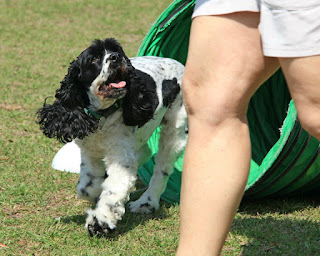What a week! The University of Kentucky Wildcats Men's basketball team won the NCAA National Championship on Monday. It was the 8th National Title (Gr8ness!) for the Big Blue Nation – and as a Kentuckian – I was (and am) so proud of my team and state…sans the couch burning.
As I watched the television coverage and award ceremony, I reflected upon our year and a half journey in competing in dog agility. While we may never compete in the USDAA Nationals (not too many Cocker Spaniels can run faster than border collies and shelties!), I intend to learn as many handling strategies used by the agility "greats" such as Linda Mecklenburg and Daisy Peel so that Team J-Dawg can master running more advanced agility courses.
As I watched the television coverage and award ceremony, I reflected upon our year and a half journey in competing in dog agility. While we may never compete in the USDAA Nationals (not too many Cocker Spaniels can run faster than border collies and shelties!), I intend to learn as many handling strategies used by the agility "greats" such as Linda Mecklenburg and Daisy Peel so that Team J-Dawg can master running more advanced agility courses.
During one recent class, I learned a very useful handling technique – the reverse flow pivot (RFP). This is a great tool for me to have in my arsenal as we begin to face more challenging courses that require obstacle discrimination and other complex moves. While at first the reverse flow pivot seemed quite awkward, I learned how to better handle this move. In a reverse flow pivot, the handler turns into the dog and toward the last obstacle taken like a front cross, but once the dog changes direction, the handler then pivots back and picks up the dog on the same side and redirects the dog toward the correct obstacle; hence, the name – reverse flow pivot (RFP). We used this handling technique to help the dog discriminate between an A-frame and a tunnel, getting the dog to take the tunnel. Below is an example I gleaned while “Googling." I really loved this diagram! The handler would use the RPF to redirect the dog's path from the A-Frame to jump #6.

Here's the link for more information:
In another instance, we used the reverse flow pivot to run a line of threadles. Team J-Dawg had more success with handling the threadle – only because we have practiced that move before I knew the fancy name for it (RFP)! Since Jefferson is an obstacle-focused dog, I have learned to strategically use his name whenever I want him to become handler focused and check-in with me for directions. So, whenever I pivot into him during this handling move, I say his name so I can re-direct him. Through trial-and-error, this seems to work like a charm.
Another handling technique to which I have learned to pay attention is to be more aware of my motion as I run a course. I have been reading Linda Mecklenburg’s book Developing Handling Skills for Awesome Agility Teams and she has a very detailed explanation of the handler cues that a dog reads while running a course.
According to Mecklenburg (and from my limited experience in agility!), motion is the primary cue because it is the “natural” cue, i.e. the cue the dog responds to without excess training. This explains why when I am running full throttle toward the tunnel and give Jefferson the verbal command “go teeter” he takes the tunnel ;-) He was reading my motion cue and NOT my verbal cue. Obviously, verbal commands are much lower on the hierarchy. So, my job as the other half of Team J-Dawg, is to capitalize on the “natural” cues that Jefferson reads. I have been working on being more cognizant of my motion, the direction my feet are facing, and my shoulders. He reads the subtlety of all these “natural” cues.
Overall, it seems that I have quite a bit of work left before the upcoming weeks’ trials! I feel very positive about our progress – or should I say “my” progress in becoming a more attuned handler. Being a great dog agility team is definitely about the journey and what we learn along the way.
"Greatness is not measured by what a man or woman accomplishes, but by the opposition he or she has overcome to reach his goals."
-Dorothy Height
-Dorothy Height





No comments:
Post a Comment